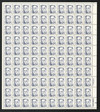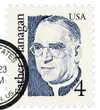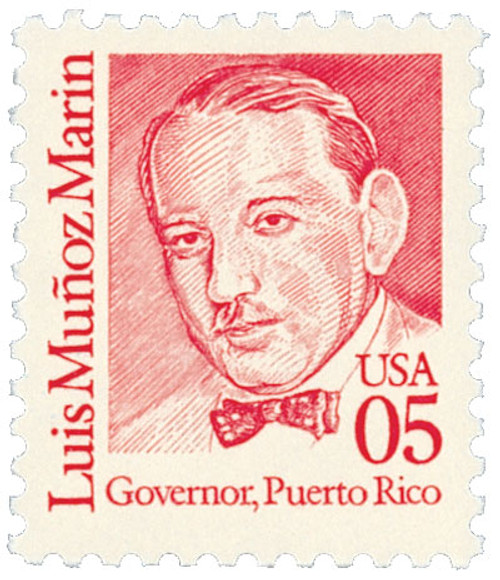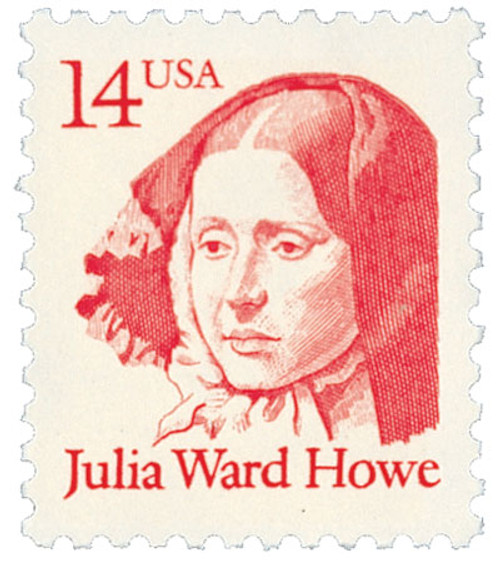
# 2171 - 1986 4c Great Americans: Father Flanagan
U.S. #2171
1986 4¢ Father Flanagan
Great Americans
- Flanagan was the sixth Catholic leader on a US stamp
- Issued for Flanagan’s 100th birthday
- Flanagan founded Boys Town, a non-profit organization that helps children and families
Stamp Category: Definitive
Series: Great Americans
Value: 4¢, used for make-up postage
First Day of Issue: July 14, 1986
First Day City: Omaha, Nebraska
Quantity Issued: 48,600,000
Printed by: Bureau of Engraving and Printing
Printing Method: Engraved
Format: Panes of 100 in sheets of 800
Perforations: 11
Color: Blue violet
Why the stamp was issued: This 4¢ stamp is what the USPS calls “change maker” postage. These stamps with denominations of 1¢ through 6¢ are produced to make up the wide variety of rates for third-class parcel post, which has many combinations of charges for weight and distance. These stamps were also useful when first-class rates went up, before the USPS could release stamps at the new rate.
About the stamp design: Flanagan had been on the USPS list of protentional honorees for several years. As early as 1948, Senator Kenneth S. Wherry had suggested such a stamp, saying Flanagan was a “most suitable subject for a stamp.” The stamp features artwork by Chris Calle based on a photo provided by Boys Town.
Special design details: Because including his full name would require the type to be quite small, the USPS opted to use simply “Father Flanagan” reasoning that was likely more recognizable to a larger number of people.
First Day City: The First Day ceremony for this stamp was held at the Boys Town High School in Omaha, Nebraska.
Unusual fact about this stamp: There are a variety of errors of this stamp. Tagging omitted with blue violet ink (2171c), untagged with grayish violet ink (2171a), untagged with deep grayish blue ink (2171b), and all color missing (2171d). #2171 has an “albino impression” and may be found fully or partially printed.
About the Great Americans Series: The Great Americans Series was created to replace the Americana Series. The new series would be characterized by a standard definitive size, simple design, and monochromatic colors.
This simple design included a portrait, “USA,” the denomination, the person’s name, and in some cases, their occupation or reason for recognition. The first stamp in the new series was issued on December 27, 1980. It honored Sequoyah and fulfilled the new international postcard rate that would go into effect in January 1981.
The Great Americans Series would honor a wider range of people than the previous Prominent Americans and Liberty Series. While those series mainly honored presidents and politicians, the Great Americans Series featured people from many fields and ethnicities. They were individuals who were leaders in education, the military, literature, the arts, and human and civil rights. Plus, while the previous series only honored a few women, the Great Americans featured 15 women. This was also the first definitive series to honor Native Americans, with five stamps.
The Bureau of Engraving and Printing (BEP) produced most of the stamps, but private firms printed some. Several stamps saw multiple printings. The result was many different varieties, with tagging being the key to understanding them. Though there were also differences in perforations, gum, paper, and ink color.
The final stamp in the series was issued on July 17, 1999, honoring Justin S. Morrill. Spanning 20 years, the Great Americans was the longest-running US definitive series. It was also the largest series of face-different stamps, with a total of 63.
Click here for all the individual stamps and click here for the complete series.
History the stamp represents: Monsignor Edward Joseph Flanagan was born on July 13, 1886, in Leabeg, Ireland.
After attending Summerhill College in Ireland, Flanagan moved to the United States in 1904. He then attended Mount St. Mary’s University in Maryland, where he graduated with a Bachelor of Arts and a Master of Arts degree in 1908.
From there, Flanagan studied at St. Joseph’s Seminary in Dunwoodie, New York and the University of Innsbruck in Austria. He was ordained as a priest there in 1912. Flanagan then returned to the US where he led his first parish – a St. Patrick’s Catholic Church in O’Neill, Nebraska.
Through his work as a priest, Flanagan became concerned for orphaned boys and boys who had broken the law. In 1917, he took in eight neglected and orphaned boys, creating his first home for homeless boys in Omaha. However, those facilities were soon considered inadequate and he opened Boys Town ten miles west of Omaha in 1921. Over the coming years, Boys Town developed into a large community with its own boy-mayor, schools, chapel, post office, homes, gymnasium, and other facilities. The town was open to boys between the ages of 10 and 16 and gave them the chance to receive an education and learn a job skill.
In 1938, Flanagan’s Boys Town inspired a movie starring Spencer Tracy and Mickey Rooney. Some of the film’s scenes were filmed in Boys Town, and Flanagan was invited to review the script before filming began. Tracy won an Academy Award for Best Actor for his performance, and the Academy then gave Boys Town its own award, which read, “To Father Flanagan, whose great humanity, kindly simplicity, and inspiring courage were strong enough to shine through my humble effort. Spencer Tracy.” There was also a sequel in 1941, Men of Boys Town.
Father Flanagan received national attention for his work at Boys Town. The Pope named him a Domestic Prelate with the title Right Reverend Monsignor. He was also invited to participate in several committees that dealt with child welfare. In the 1940s, he traveled to other countries to inspect their child welfare problems, but was forced to leave his homeland of Ireland after calling the children’s institutions a “national disgrace.”
Father Flanagan died from a heart attack while in Germany on May 15, 1948. Boys Town continued on after his passing and spread to five other states plus Washington, DC.
U.S. #2171
1986 4¢ Father Flanagan
Great Americans
- Flanagan was the sixth Catholic leader on a US stamp
- Issued for Flanagan’s 100th birthday
- Flanagan founded Boys Town, a non-profit organization that helps children and families
Stamp Category: Definitive
Series: Great Americans
Value: 4¢, used for make-up postage
First Day of Issue: July 14, 1986
First Day City: Omaha, Nebraska
Quantity Issued: 48,600,000
Printed by: Bureau of Engraving and Printing
Printing Method: Engraved
Format: Panes of 100 in sheets of 800
Perforations: 11
Color: Blue violet
Why the stamp was issued: This 4¢ stamp is what the USPS calls “change maker” postage. These stamps with denominations of 1¢ through 6¢ are produced to make up the wide variety of rates for third-class parcel post, which has many combinations of charges for weight and distance. These stamps were also useful when first-class rates went up, before the USPS could release stamps at the new rate.
About the stamp design: Flanagan had been on the USPS list of protentional honorees for several years. As early as 1948, Senator Kenneth S. Wherry had suggested such a stamp, saying Flanagan was a “most suitable subject for a stamp.” The stamp features artwork by Chris Calle based on a photo provided by Boys Town.
Special design details: Because including his full name would require the type to be quite small, the USPS opted to use simply “Father Flanagan” reasoning that was likely more recognizable to a larger number of people.
First Day City: The First Day ceremony for this stamp was held at the Boys Town High School in Omaha, Nebraska.
Unusual fact about this stamp: There are a variety of errors of this stamp. Tagging omitted with blue violet ink (2171c), untagged with grayish violet ink (2171a), untagged with deep grayish blue ink (2171b), and all color missing (2171d). #2171 has an “albino impression” and may be found fully or partially printed.
About the Great Americans Series: The Great Americans Series was created to replace the Americana Series. The new series would be characterized by a standard definitive size, simple design, and monochromatic colors.
This simple design included a portrait, “USA,” the denomination, the person’s name, and in some cases, their occupation or reason for recognition. The first stamp in the new series was issued on December 27, 1980. It honored Sequoyah and fulfilled the new international postcard rate that would go into effect in January 1981.
The Great Americans Series would honor a wider range of people than the previous Prominent Americans and Liberty Series. While those series mainly honored presidents and politicians, the Great Americans Series featured people from many fields and ethnicities. They were individuals who were leaders in education, the military, literature, the arts, and human and civil rights. Plus, while the previous series only honored a few women, the Great Americans featured 15 women. This was also the first definitive series to honor Native Americans, with five stamps.
The Bureau of Engraving and Printing (BEP) produced most of the stamps, but private firms printed some. Several stamps saw multiple printings. The result was many different varieties, with tagging being the key to understanding them. Though there were also differences in perforations, gum, paper, and ink color.
The final stamp in the series was issued on July 17, 1999, honoring Justin S. Morrill. Spanning 20 years, the Great Americans was the longest-running US definitive series. It was also the largest series of face-different stamps, with a total of 63.
Click here for all the individual stamps and click here for the complete series.
History the stamp represents: Monsignor Edward Joseph Flanagan was born on July 13, 1886, in Leabeg, Ireland.
After attending Summerhill College in Ireland, Flanagan moved to the United States in 1904. He then attended Mount St. Mary’s University in Maryland, where he graduated with a Bachelor of Arts and a Master of Arts degree in 1908.
From there, Flanagan studied at St. Joseph’s Seminary in Dunwoodie, New York and the University of Innsbruck in Austria. He was ordained as a priest there in 1912. Flanagan then returned to the US where he led his first parish – a St. Patrick’s Catholic Church in O’Neill, Nebraska.
Through his work as a priest, Flanagan became concerned for orphaned boys and boys who had broken the law. In 1917, he took in eight neglected and orphaned boys, creating his first home for homeless boys in Omaha. However, those facilities were soon considered inadequate and he opened Boys Town ten miles west of Omaha in 1921. Over the coming years, Boys Town developed into a large community with its own boy-mayor, schools, chapel, post office, homes, gymnasium, and other facilities. The town was open to boys between the ages of 10 and 16 and gave them the chance to receive an education and learn a job skill.
In 1938, Flanagan’s Boys Town inspired a movie starring Spencer Tracy and Mickey Rooney. Some of the film’s scenes were filmed in Boys Town, and Flanagan was invited to review the script before filming began. Tracy won an Academy Award for Best Actor for his performance, and the Academy then gave Boys Town its own award, which read, “To Father Flanagan, whose great humanity, kindly simplicity, and inspiring courage were strong enough to shine through my humble effort. Spencer Tracy.” There was also a sequel in 1941, Men of Boys Town.
Father Flanagan received national attention for his work at Boys Town. The Pope named him a Domestic Prelate with the title Right Reverend Monsignor. He was also invited to participate in several committees that dealt with child welfare. In the 1940s, he traveled to other countries to inspect their child welfare problems, but was forced to leave his homeland of Ireland after calling the children’s institutions a “national disgrace.”
Father Flanagan died from a heart attack while in Germany on May 15, 1948. Boys Town continued on after his passing and spread to five other states plus Washington, DC.





















